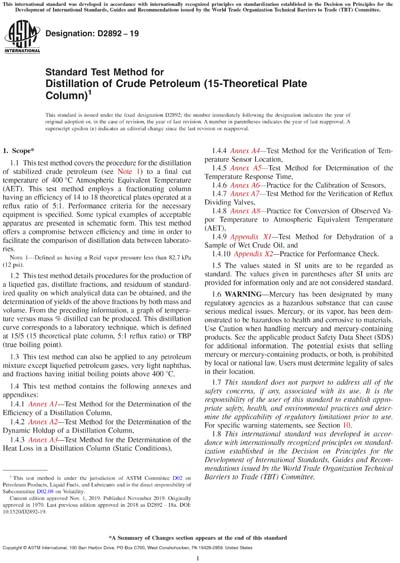Historical
ASTM D2892-19
Standard Test Method for Distillation of Crude Petroleum (15-Theoretical Plate Column)
1.1 This test method covers the procedure for the distillation of stabilized crude petroleum (see Note 1) to a final cut temperature of 400 °C Atmospheric Equivalent Temperature (AET). This test method employs a fractionating column having an efficiency of 14 to 18 theoretical plates operated at a reflux ratio of 5:1. Performance criteria for the necessary equipment is specified. Some typical examples of acceptable apparatus are presented in schematic form. This test method offers a compromise between efficiency and time in order to facilitate the comparison of distillation data between laboratories.
Note 1: Defined as having a Reid vapor pressure less than 82.7 kPa (12 psi).
1.2 This test method details procedures for the production of a liquefied gas, distillate fractions, and residuum of standardized quality on which analytical data can be obtained, and the determination of yields of the above fractions by both mass and volume. From the preceding information, a graph of temperature versus mass % distilled can be produced. This distillation curve corresponds to a laboratory technique, which is defined at 15/5 (15 theoretical plate column, 5:1 reflux ratio) or TBP (true boiling point).
1.3 This test method can also be applied to any petroleum mixture except liquefied petroleum gases, very light naphthas, and fractions having initial boiling points above 400 °C.
1.4 This test method contains the following annexes and appendixes:
1.4.1 Annex A1—Test Method for the Determination of the Efficiency of a Distillation Column,
1.4.2 Annex A2—Test Method for the Determination of the Dynamic Holdup of a Distillation Column,
1.4.3 Annex A3—Test Method for the Determination of the Heat Loss in a Distillation Column (Static Conditions),
1.4.4 Annex A4—Test Method for the Verification of Temperature Sensor Location,
1.4.5 Annex A5—Test Method for Determination of the Temperature Response Time,
1.4.6 Annex A6—Practice for the Calibration of Sensors,
1.4.7 Annex A7—Test Method for the Verification of Reflux Dividing Valves,
1.4.8 Annex A8—Practice for Conversion of Observed Vapor Temperature to Atmospheric Equivalent Temperature (AET),
1.4.9 Appendix X1—Test Method for Dehydration of a Sample of Wet Crude Oil, and
1.4.10 Appendix X2—Practice for Performance Check.
1.5 The values stated in SI units are to be regarded as standard. The values given in parentheses after SI units are provided for information only and are not considered standard.
1.6 WARNING—Mercury has been designated by many regulatory agencies as a hazardous substance that can cause serious medical issues. Mercury, or its vapor, has been demonstrated to be hazardous to health and corrosive to materials. Use Caution when handling mercury and mercury-containing products. See the applicable product Safety Data Sheet (SDS) for additional information. The potential exists that selling mercury or mercury-containing products, or both, is prohibited by local or national law. Users must determine legality of sales in their location.
1.7 This standard does not purport to address all of the safety concerns, if any, associated with its use. It is the responsibility of the user of this standard to establish appropriate safety, health, and environmental practices and determine the applicability of regulatory limitations prior to use. For specific warning statements, see Section 10.
1.8 This international standard was developed in accordance with internationally recognized principles on standardization established in the Decision on Principles for the Development of International Standards, Guides and Recommendations issued by the World Trade Organization Technical Barriers to Trade (TBT) Committee.
Content Provider
ASTM International [astm]






